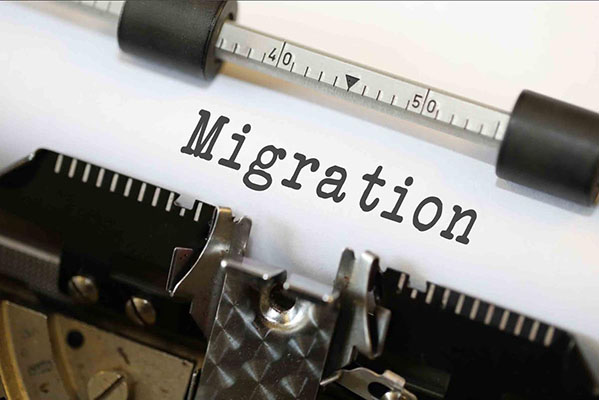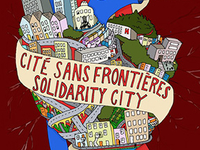Migration, On the Move

October 25, 2019
The dynamics of migration and flight are, simply put, the result of an inequitable global distribution of social, economic, cultural, and political rights. We would not reflect on or talk about migration if the modern globalized world was not divided through borders into nation-states. The political order of the modern world is determined by the national and supranational structures which claim the right to decide upon citizenship and territory. The increasingly restrictive measures to control migratory processes, particularly the flow of asylum seekers, have been a remarkable feature of migration, for example along the frontiers of Europe or the United States, just to give two popular and much discussed examples.
Citizenship is an achievement of modern times, on the one hand, but it is an exclusive mechanism and motor of social inequality, on the other. People need to cross borders to study, to work, or to find better conditions for their livelihood because of unacceptable living conditions. However, migration is an old phenomenon: people have been migrating since the dawn of human history. Gerda Heck reminds us in her reflections on “European Imaginations and African Mobility Realities” of a long forgotten migration history. The African continent has been a “safe haven” for thousands of refugees and economic migrants from Europe seeking refuge and/or a better life in the nineteenth and twentieth century.
Nowadays, globalization is a fundamental driving force of migration and flight; this powerful force has reduced the effects of spatial distance. Currently the number of countries and of people that are included in migratory processes is much higher than at any previous time in history.
Past and contemporary policies on immigration play an important role in migration flows. The relationship between increasing transnational flows of capital, goods, information, and people is another aspect. The international migratory process is based on an interplay between multiple factors, and it is impossible to identify one main pattern of movement. The migratory process may be caused by economic, political, cultural, or environmental factors. For example, the United Nations High Commissioner for Refugees predicts that climate change will trigger enormous refugee movements over the next few years. Likewise, land grabbing has become a major reason for multiple displacements.
Migration cannot be regarded as an isolated phenomenon; rather, it should be seen as an interlaced relationship of the above factors. International migration is not a process in which people migrate from one country to another; rather the migration process must be viewed as a lasting phenomenon, surpassing spatial and temporal boundaries. Carlos Sandoval reflects on the social moments of such migration movements in his contribution, “The Central American Caravan: A Twenty-First Century Exodus.” This caravan is motivated by a variety of factors: The poverty rate, the increasing costs of electricity, natural gas, and gasoline trigger the collective exodus of people from Honduras or El Salvador. People migrate in groups and cross the borders together. The caravan not only offers protection against violence such as kidnapping or extortion but shows the collective moments of migration at the same time.
Globalization has led to an easier crossing of borders and to a strengthening of economic relations. The global restructuring of capitalism leads to a great demand for immigrant labor. Migrant labor plays an important role in the national economies of receiving countries. As Bediz Yilmaz shows for Turkey, this work is often informal. 3.6 million Syrians who escaped war now live in Turkey. The exploitation of Syrian workers is a widespread phenomenon tolerated by Turkish authorities. Yılmaz’s contribution, “Refugees as Unfree Labor Force: Notes from Turkey,” discusses the exploitative conditions of unfree labor.
We observe an expansion and a continuation of international migration across temporal and spatial boundaries. Many migrants now manage to live in two or more societies: their homeland and their host countries. Transnational migrants create a common space or field of symbolic and collective representations beyond the nation-state. Diversity is one major aspect of modern migration movements. There is a wide range of migrant types: asylum seekers, refugees, undocumented migrants, and labor migrants (who include intellectual or business elites as well as domestic workers).
Contemporary migration flows have become globally significant because of the improvement of travel and communication facilities. We can communicate across borders and open transnational spaces of communication. Recently I visited Vercana, a beautiful place in Italy. There I talked to a friend who grew up in Yemen and went back for three weeks right at the time of the missile strike on Aden. She visited her family and wrote about the famine and the people who got killed. She reported about the sound of the falling missiles. New information and communication technologies make the experience of the contemporaneousness of the non-contemporaneous possible. We can experience the social consequences of injustice, war, and persecution as it happens in real time. Media promotes not only the spread of injustice but also the enhancement of better living conditions, migration routes, and democratic rights.
As the famous sociologist Zygmunt Bauman stated: “the riches are global, the misery is local.” It depends on money, citizenship, or gender whether people have the right and the opportunities to migrate.
We observe undoubtedly ambivalent dynamics between the facilitation of movement and the hermetic worldwide stop of it. The aggressive politics of Donald Trump to build a wall between the United States and Mexico and the creation and implementation of a fortress Europe are popular examples. We observe simultaneously the upsurge of right-wing movements and a new aggressive nationalism, as well as acts of solidarity. The global spreading of ideas based on human rights leads to movements against restrictive policies. Sarah Schilliger tells us in her contribution titled “Undoing Borders in SolidarityCities”about the concept of Solidarity Cities. The political space of the city has become a field of democratization of urban life. The concept of citizenship will be viewed not as a status but as a process which includes negotiation over belonging and access to rights.
Thinking about migration means to reflect on the contingency of borders, the criteria of belonging, and the entitlement to as well as the exercise of rights in a modern unequal and globalized world.
Karin Scherschel, RheinMain University of Applied Sciences, Germany <Karin.Scherschel@hs-rm.de>


















